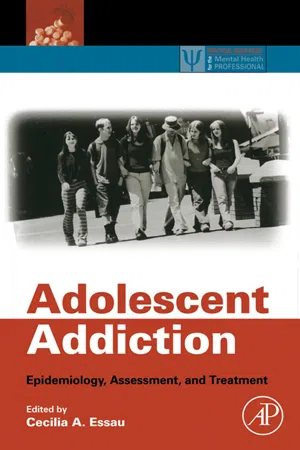DEFINITIONS OF ADDICTION
Ideas about the concept of addiction abound. It is often conceived as being both a personal and a social problem – in the former case, addiction is viewed as a weakness residing within the adolescent who lacks control and motivation; in the latter, addiction is associated with impoverished environments and lack of opportunity. Definitional criteria regarding addiction are ambiguous.
There are at least two factors that contribute to a lack of clear understanding of the concept of addiction. The way addiction is conceptualized has changed over time, and there is no universally accepted (or utilized) definition – the definition of addiction has gradually evolved. In earlier times, addiction was equated with physiological dependence (West, 2006). Traditionally, addiction was considered to be a response to a substance taken by a person – as physiological adaptation to a drug, without which the person would experience withdrawal. That is, addiction was perceived as being a condition in which a person requires a substance (i.e., a drug) in order to function without physical and psychological reactions to its absence, and which often involves tolerance and dependence (Carpenter, 2001).
This idea that addiction results solely from substance use is believed even now. Some professionals (including addiction counsellors) still hold this view (Walters and Gilbert, 2000). Likewise, expert definitions can be found that restrict the object of addiction to drugs. For example, in The Merck Manual, a biomedical manual, addiction has been defined within the spectrum of substance use disorders (Berkow et al., 1997: Sec. 15, Ch. 195), especially in comparing and contrasting ideas of physical and psychological dependence:
Addiction, a concept without a consistent, universally accepted definition, is used here to refer to a lifestyle characterized by compulsive use and overwhelming involvement with a drug; it may occur without physical dependence. Addiction implies the risk of harm and the need to stop drug use, whether the addict understands and agrees or not.
Consistent with biomedical definitions, addiction has also been described as a biobehavioral disorder (Leshner, 2001) resulting from a series of changes in the brain, these neuroadaptations being caused by repeated exposure. It is hypothesized that damage to the frontal cortex of the brain impairs the decision-making abilities influencing behavioral inhibition toward, in this case, the drug. The concept of addiction portrayed from this perspective, although perhaps too narrowly focused on drugs, is helpful for understanding concepts shared with substance use disorders.
Even within the strict application of addition to a substance (i.e., a drug), there has been a loosening of the concomitant ideas of dependence. Current understanding of addiction appears to be moving even further toward a broader definition encompassing a syndrome with heterogeneous symptoms, including a problem of compulsive behavior (and perhaps compulsive cognitions) regarding an object of desire. There is an expanded application of the term “addiction” to a wide range of items of pleasure – that is, in other arenas it has been extended to include various objects of desire, such as gambling, the Internet, and sex addictions. Other key inclusions are ideas of compulsivity, risk of harm, and problems with motivation.
West (2006) provides a definition of addiction as a syndrome involving reward-seeking behavior which results in significant harm. In this view, addiction is defined as a problem in a person’s motivational system. Addiction also involves impulses or cravings, perceived needs, and a person’s sense of identity (West, 2006). It may involve dependence – physical or psychological – and intoxication. There does appear to be an effect on the choices people make, the emotional attachment they have to the object of desire; this has elements of habitual behavior, and largely involves behavior and feelings.
Common to these definitions is compulsive behavior, regarding an object of desire, which implies a risk of harm and problematic actions. How addiction is viewed influences how society and experts respond, and how research into addiction is conducted.
Walters and Gilbert (2000) have attempted to elucidate an operational definition of addiction. In previous work, Walters (1999) determined that there might be four key elements to an operational definition: a general progression element (comprising physical and psychological dependence), preoccupation, perceived loss of control, and persistence in the face of mounting negative consequences. Walters and Gilbert (2000) asked clients enrolled in a drug education class (n = 31), and Fellows (n = 20) of the American Psychological Association (Division on Addictions only), to define the concept of addiction. Not one subject provided a definition that contained all four elements. Furthermore, there was significant d...
